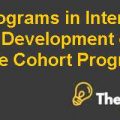GENENTECH-CAPACITY PLANNING Case Solution
Question 1
Should Genentech move forward with CCP3? If yes, what size production lines (tank sizes) would you recommend? Why? What should be the total size of the facility? Please back your answer with the numbers you obtained on the spreadsheet.
It is recommended for Genentech Company to not to go ahead with CCP3. At least the management of the company needs to wait about 1 more year in order to see the success of the trials of the product on certain cancer diseases. If the rate of success is expected and the demand of the product shows growth then more analysis could be conducted and the decision can move forward. If the company goes ahead with CCP3 now and the trials fail resulting in lower demand for the company, then the company would end up holding masses of inventory which would as a result increase the holding costs and the administrative costs of the company. The most significant impact on the entire demand of Avastin would be from the trials of the lung and the cancer patients and if these fail in phase III then the excess capacity would destroy the profits of the company and eat up its resources.
Along with this, the batch numbers would be 15 batches per year and the number of the tanks required need to be 12 as for CCP1. However, in order to make the design of the plant optimal the most economic way would be to build the plants with 12,000 liters cell lines rather than 25,000 cell liters lines. The reason for this is clear that the costs would be low and if all the current nine phase 3 trials are successful but their demand declines, then the impact on the profitability and the capacity would be minimal.
Moreover, if management decided to build another 25,000 liter plant then the smaller plants would be lost therefore, it would be most feasible to build 12,000 liters cell lines. There are also many significant advantages associated with 25,000 liters cell lines such as it would double the capacity and it would also support the new cost structures with higher profit margins and appealing cost structures however, as the quantities of the capacity are completely unknown and the lower probabilities of success make it more feasible to build the production lines with 12,000 liter cell lines. The probabilities are shown below:
| Trial stage | % success | |||
| Lung | ||||
| front-line |
3 |
60% |
||
| other |
2 |
50% |
||
| Breast | ||||
| front-line |
3 |
50% |
||
| other |
2 |
50% |
||
| Kidney | ||||
| front-line |
3 |
80% |
||
| other |
2 |
50% |
||
| Pancreatic | ||||
| front-line |
3 |
50% |
||
| other |
2 |
50% |
||
| Other | ||||
| front-line |
3 |
50% |
||
| other |
3 |
50% |
||
When the capacity of each of the tanks would be 12,000 liters then the total capacity of the facility would be 144000 liters............
This is just a sample partial case solution. Please place the order on the website to order your own originally done case solution.












